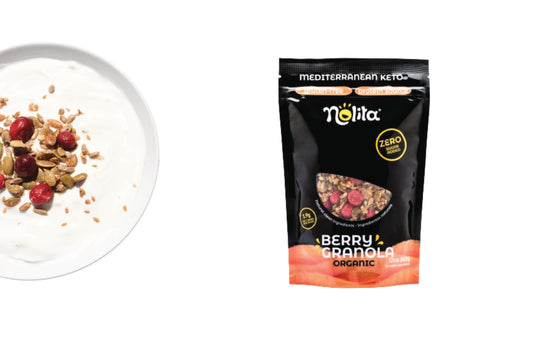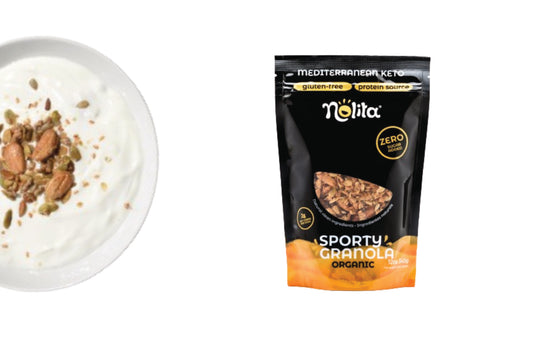One of the most important biomarkers of our body is the blood sugar level. It is a crucial signal for our overall health as it measures the amount of glucose in our bloodstream (the main source of energy for our body). But when levels are too high or too low, it can cause a variety of health problems. Hyperglycemia (high blood sugar) can be caused by a variety of things, such as:
-
stress,
-
an inactive lifestyle,
-
poor food choices.
In this article, we focus on the last point: bad food choices.
Image 1: Food choices by: Karolina Grabowska
What foods can raise blood sugar?
We all know by now that sugary drinks raise blood sugar levels. This happens because these foods contain among their ingredients the so-called “liquid sugars” such as corn syrup, honey and agave for example. It is essential to avoid them and consume them in moderation.
Now, what many still don't know is why these sugars are even more harmful to our body than the white sugar that we often consume in desserts or snacks.
These “liquid sugars” are none other than fructose. “But doesn't fructose come from fruit? It's healthy then, right?"
Image 2:Fruit bowl by: Jo Sonn
WRONG. Fructose is present in fruits, yes, but it is not healthy if it is not consumed as a whole fruit. That's why a natural orange juice can be quite harmful. Find out why later in this article.
What are the risks?
Several studies linked a high intake of fructose to a decrease in insulin sensitivity (not good) and an increased risk of type 2 diabetes. Furthermore, frequent intake of sugary drinks is linked to non-alcoholic fatty liver disease (NAFLD), because these fructose-rich drinks are consumed in a short period of time.
Various organs such as the pancreas, intestine and liver process the digested sugar in its solid form along the entire food chain. But the liver is the only organ that processes liquid sugars. These enter the bloodstream almost immediately and as they are not accompanied by fiber and/or protein, they are absorbed quickly, overloading the liver in a short period of time.
The longer the sugar ingestion time, the less overload the organs that process it.
In this case, solid sugars are less harmful than liquid ones because the intestine, pancreas and liver process these sugars together over a longer period of time (during the entire period of digestion) and therefore these organs are not overloaded during the process.
Image 3: Fatty liver by:Getty Images
Also, when more fructose is consumed than the liver can store as glucose, the extra fructose is converted into fat. Some of this fat is stored in the liver, which can lead to inflammation, insulin resistance and fatty liver.
The danger of an orange juice:
There are fruits with higher amounts of sugar than others. Bananas and grapes, for example, have more glucose than a tangerine. However, you should not avoid eating these fruits. Instead, you should be aware of how they affect your glucose and find out how to consume them differently, for instance how to combine them with proteins, fibers or fats or consume them in lesser quantity.
Image 4: Orange juice by: Greg Rosenke
Another unexpected food that can raise blood sugar levels is orange juice. It has an average peak glucose of 40 milligrams per deciliter. Fruit juice is something that Dr. Casey Means advises avoiding because it's essentially liquid sugar. In juice machines, the skin and pulp of the fruits (which contain fiber) are retained, leaving only the juice with fructose (sugar) in the glass. This sugar, as it is not accompanied by fiber, enters the bloodstream directly and is processed by the liver. Since only the liver processes the liquid sugar, it becomes overloaded and may go bankrupt and cause serious liver problems.
How to get around the situation?
If we extend the consumption time of the fructose drink and add some fiber, protein or fat, we can significantly reduce the consequences of fructose in the blood. This happens because the fibers and proteins accompanying fructose create a kind of “barrier” to its rapid absorption, leading it along the entire digestive tract so that it is absorbed in more time by various organs.
Image 5: Glucose Spike Graphic (adapted from @glucosegoddess)
So should I stop eating fruit?
NO ! The fruit should be consumed regularly as it is rich in vitamins, minerals and antioxidants essential to our health and well-being. What you should do is eat this fruit with the peel (preserving the natural fiber of the fruit), or consume the fruit with foods rich in fiber, protein or fat such as yogurt with chia seeds, or a handful of dried fruit for example. If you choose to keep the peel of fruits, make sure they are organic, as the peel is where pesticides are concentrated.
The Bottom Line
|
Photo:dominika roseclay
Bibliography
[1]Means, C. (2021, April 21). The Worst and Best Foods for Your Blood Sugar, with Dr. Casey Means. Levels Health Podcast. https://www.levelshealth.com/podcasts/the-worst-and-best-foods-for-your-blood-sugar-with-dr-casey-means
[2]Spritzler, F., (2021, January 19). Liquid Sugar Calories: The Worst Drink for Weight Gain. Healthline. https://www.healthline.com/nutrition/liquid-sugar-calories#weight-gain
[3] Schwingshackl, L., Missbach, B., & König, J. (2018). Nutrition and blood glucose control in Type 2 diabetes: systematic review and meta-analysis of randomized controlled trials. Nutrition, metabolism, and cardiovascular diseases, 28(7), 665-677. https://doi.org/10.1016/j.numecd.2018.03.002










